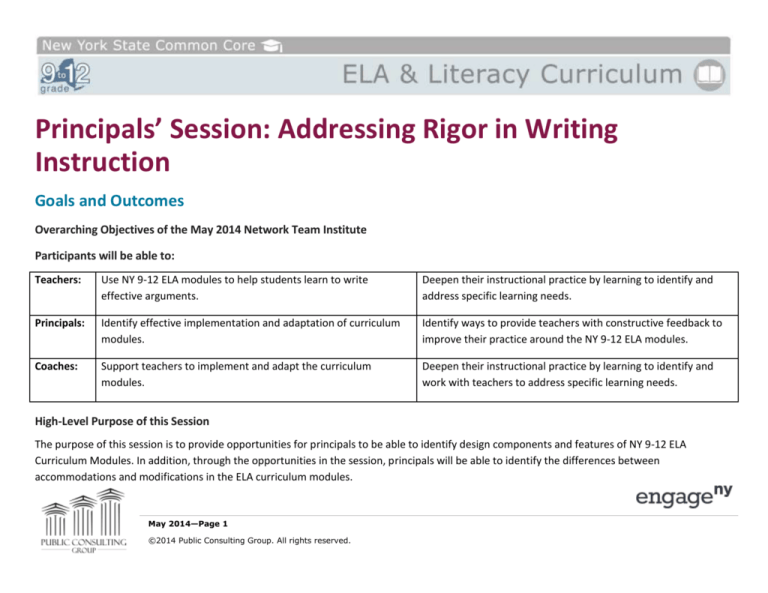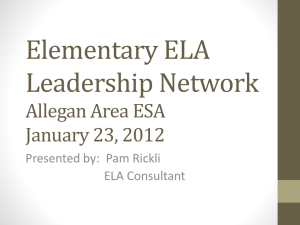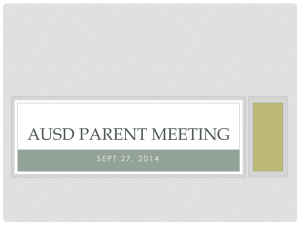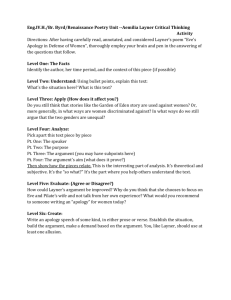
Principals’ Session: Addressing Rigor in Writing
Instruction
Goals and Outcomes
Overarching Objectives of the May 2014 Network Team Institute
Participants will be able to:
Teachers:
Use NY 9-12 ELA modules to help students learn to write
effective arguments.
Deepen their instructional practice by learning to identify and
address specific learning needs.
Principals:
Identify effective implementation and adaptation of curriculum
modules.
Identify ways to provide teachers with constructive feedback to
improve their practice around the NY 9-12 ELA modules.
Coaches:
Support teachers to implement and adapt the curriculum
modules.
Deepen their instructional practice by learning to identify and
work with teachers to address specific learning needs.
High-Level Purpose of this Session
The purpose of this session is to provide opportunities for principals to be able to identify design components and features of NY 9-12 ELA
Curriculum Modules. In addition, through the opportunities in the session, principals will be able to identify the differences between
accommodations and modifications in the ELA curriculum modules.
May 2014—Page 1
©2014 Public Consulting Group. All rights reserved.
New York State Common Core
Session Outcomes
What do we want participants to be able to do as a result of this session?
How will we know that they are able to do this?
Principals will be able to identify components of a rigorous lesson designed for
argument writing.
Aligned Survey Questions
Principals will be able to support ELA teachers by providing specific feedback
designed to increase rigor in the classroom as it relates to argument writing.
Aligned Survey Questions
Related Learning Experiences
Addressing Rigor in Writing Instruction
Key Points
Argument writing instruction through CCCS embraces text-based evidence.
May 2014—Page 2
©2014 Public Consulting Group. All rights reserved.
New York State Common Core
Session Overview
Section
Differences in
Argument Writing
Time
30 min
Overview
Prepared Resources
After receiving a high-level
overview of the curriculum design,
principals will reflect on the
differences between argument
writing instruction not aligned with
CCSS and the CCSS aligned
curriculum.
Session PowerPoint
Lesson 10 from Module 9.4
Handout – Lesson 10 Activity
Facilitator Preparation
Download and read all session
materials
Q & A for principals
Participants will use the same
selected lessons from Module 9.4
to review for rigor using these
guiding questions:
Rigor in Writing
Instruction
45 min
Where are areas of challenge
for your teachers and
students?
Where does the lesson provide
access?
Where does the lesson provide
guided practice and support?
May 2014—Page 3
©2014 Public Consulting Group. All rights reserved.
Session PowerPoint
Instructional Practice Evidence
Guide ELA 6-12
Download and read all session
Handout – Video Discussion –
materials
Day 1
Lesson 16 from Module 9.4
Handout – Lesson 16 Activity
New York State Common Core
Section
Time
Overview
Differences in
Assessing Argument
Writing
Coaching Feedback to
Teachers around
Argument Writing
Instruction
45 min
50 min
Prepared Resources
Facilitator Preparation
Where does the lesson support
independent practice?
Where are the opportunities to
increase these supports?
Briefly review the six instructional
sub-shifts to set the context for
the high quality assessments.
Principals will reflect on the
differences between writing
instruction not aligned with CCSS
and the CCSS aligned curriculum as
they review the CCSS-aligned
assessments for argument writing
in Module 9.4 to establish the
connection between aligned
instruction and student success
with assessments.
Principals will review how to use
“coaching” feedback with teachers
who show a lack of CCSS-aligned
writing instruction. Leaders will
more deeply understand their
May 2014—Page 4
©2014 Public Consulting Group. All rights reserved.
Session PowerPoint
9.4 Performance Assessment
Lesson 10 from 9.4
Evaluating Argument and
Evidence Tool 9.4.1.L10
Lesson 24 from 9.4 (pp. 1-3)
Rubric and Checklist 9.4.1.L14
Download and read all session
materials
Session PowerPoint
Download and read all session
Instructional Practice Evidence
materials
Guide ELA 6-12
New York State Common Core
Section
Time
Overview
Prepared Resources
Facilitator Preparation
responsibility in guiding teachers
towards improving argument
writing instruction.
Review Evidence Guide
Reflection and Closing 10 min
180 min
Provide case studies of lessons on
argument writing and allow
principals to give feedback to the
teacher in the case study. All case
studies are drawn from curriculum
module 9.4.
Provide opportunity for principal
reflection on feedback in small
Session PowerPoint
groups and whole group sessions.
Total for this session
May 2014—Page 5
©2014 Public Consulting Group. All rights reserved.
Download and read all session
materials
New York State Common Core
Session Roadmap
Section: Differences in Argument Writing
In this section, principals will reflect on the differences between
argument writing instruction not aligned with CCSS and the CCSS
aligned curriculum.
Slide
Time
1
0 min
Picture
Materials used include:
Session PowerPoint
Lesson 10 from Module 9.4
Handout – Lesson 10 Activity
Script/Activity Directions
Welcome participants to the session.
May 2014—Page 6
©2014 Public Consulting Group. All rights reserved.
New York State Common Core
Slide
Time
2
1 min
Picture
Script/Activity Directions
Participants will be able to identify the differences between
accommodations and modifications in the ELA curriculum modules.
Participants will be able to identify components of a rigorous lesson
designed for argument writing.
Participants will be able to support ELA teachers by providing specific
feedback designed to increase rigor in the classroom as it relates to
argument writing.
3
4 min
Traditional Curriculum vs. CCSS-Aligned Curriculum
Notes: When writing argumentatively, students also attempt to convince
the reader to accept a belief or claim/thesis as truth. Argument writing
requires the writer to provide facts/evidence to support this claim/thesis;
however, emotional appeal and anecdotal information are not considered
“hard” evidence. When constructing argument writing, writers use such
evidence that is grounded in logic and various rhetorical strategies.
Writers are also required to acknowledge and distinguish alternate claims
(counterclaims in grades 7-8), develop strengths and limitations of both
claims and counterclaim fairly (grades 9-12) and provide concrete and
measurable evidence when supporting their original claims/theses.
May 2014—Page 7
©2014 Public Consulting Group. All rights reserved.
New York State Common Core
Slide
Time
4
20 min
Picture
Script/Activity Directions
In pairs, review Lesson 10
Identify CCSS-aligned instructional practice embedded within the lesson
Determine observable teacher actions that would reflect the aligned
practice
Share out in whole-group setting
Notes: The challenge that students and teachers will encounter in this
module is that there is not a lot of direct instruction on argument writing
before students are actually assessed on it. Lesson 10 is going to require a
LOT of scaffolding. This is the first time students are introduced to terms
like “relevant” and “sufficient” when looking at, and producing, argument
writing. Up until this point, they still have not seen an argument text as a
model. Also challenging is that this is the first module that teaches
argument in 9th grade, so that is new to teachers and students.
May 2014—Page 8
©2014 Public Consulting Group. All rights reserved.
New York State Common Core
Slide
Time
5
5 min
Total
time:
30 min
Picture
Script/Activity Directions
Questions from principals about the content of the module.
May 2014—Page 9
©2014 Public Consulting Group. All rights reserved.
New York State Common Core
Section: Rigor in Writing Instruction
In this section, principals will be able to identify components of a
rigorous lesson designed for argument writing. Principals will be
able to support ELA teachers by providing specific feedback
designed to increase rigor in the classroom as it relates to
argument writing.
Materials used include:
Slide
Time
Script/Activity Directions
6
15 min
Picture
Session PowerPoint
Instructional Practice Evidence Guide ELA 6-12
Handout – Video Discussion – Day 1
Lesson 16 from Module 9.4
Handout – Lesson 16 Activity
Watch the video
What would a school leader expect to observe if the lesson is being effectively
aligned to the module?
In pairs, choose an Evidence Guide indicator
Write a CCSS-aligned instructional practice embedded within the lesson that
is emphasized within the indicator
Determine observable teacher actions that would reflect the aligned practice
Discuss in whole group.
Notes: May need to review Evidence Guide Indicator with group before the video.
May 2014—Page 10
©2014 Public Consulting Group. All rights reserved.
New York State Common Core
Slide
Time
7
30 min.
Picture
Script/Activity Directions
In Pairs, review Lesson 16; annotate while reading then answer the questions
below:
Where are areas of challenge for your teachers and students?
Where does the lesson provide access?
Where does the lesson provide guided practice and support?
Where does the lesson support independent practice?
Where are the opportunities to increase these supports?
Share out to whole group
Total
time:
45 min.
May 2014—Page 11
©2014 Public Consulting Group. All rights reserved.
New York State Common Core
Section: Differences in Assessing Argument Writing
In this section, principals will reflect on the differences between
Materials used include:
writing instruction not aligned with CCSS and CCSS aligned
Session PowerPoint
instruction as they review the CCSS-aligned assessments for
9.4 Performance Assessment
argument writing in Module 9.4 to establish the connection
Lesson 10 from 9.4
between aligned instruction and student success with assessments.
Evaluating Argument and Evidence Tool 9.4.1.L10
Lesson 24 from 9.4 (pp. 1-3)
Rubric and Checklist 9.4.1.L14
Slide
Time
8
5 min.
Picture
Script/Activity Directions
Briefly, review the six instructional shifts to set the context for the high
quality assessments
Notes:
May 2014—Page 12
©2014 Public Consulting Group. All rights reserved.
Most college and career writing requires students to take a position or
inform others citing evidence from the text, not provide a personal
opinion.
Across the grades, and even across the content areas, students need
to develop the skill of grounding their responses in evidence from the
text.
Requiring students to use evidence can and should occur during oral
discussions across all grades and content areas.
New York State Common Core
Slide
Time
Picture
Script/Activity Directions
May 2014—Page 13
©2014 Public Consulting Group. All rights reserved.
This is a sharp departure from much current practice where the focus
is commonly to relate the text to yourself in narrative expressive
pieces, where students share their views on various topics.
Even when students are reading grade-level texts, they have too often
been encouraged to write or discuss without having to use evidence
from the text.
It is easier to talk about personal responses than to analyze what the
text has to say, hence students - and teachers - are likely to engage in
this type of dialogue before a text is fully analyzed. The unintended
consequence of all of this is less time in the text more outside the text;
problematic in any case but far more so with complex text.
This is does not mean banishing personal response to a text. Though
not called for in the standards, there are times these responses and
discussion are essential. They are best done however AFTER the text is
fully analyzed. At this point students' personal responses will be
enhanced by what the text has to offer. (Achieve the Core, p. 394,
Introduction to ELA Shifts)
New York State Common Core
Slide
Time
9
25 min
10
Picture
Script/Activity Directions
Have participants read and annotate the following assessments in preparation
for discussion.
15 min
Review Assessment from Lesson 10 (p. 8-9)
Review Evaluating Argument and Evidence Tool
Review Lesson 24 (pp 1-3)
Review 9.4 Performance Assessment
Review Rubric and Checklist
At your tables, talk about your observations from your review. Use the
following questions to guide the discussion.
Total
time:
45 min.
May 2014—Page 14
©2014 Public Consulting Group. All rights reserved.
What are my impressions of the assessments for Module 9.4 Argument Writing?
Where will my teachers struggle?
Where will my students struggle?
Where are there opportunities for accommodations?
What can I do to help my teachers deliver these assessments with
fidelity?
How can I help my teachers use the data from the assessments to
increase student outcomes?
New York State Common Core
Section: Coaching Feedback to Teachers around Argument Writing Instruction
In this section, principals will review how to use “coaching”
feedback with teachers who show a lack of CCSS-aligned writing
instruction.
Materials used include:
Slide
Time
Script/Activity Directions
11
10 min
Picture
Session PowerPoint
Instructional Practice Evidence Guide ELA 6-12
Framing: Leaders’ role is to provide possibly difficult feedback by making
evidence supported claims, not as a “gotcha” but as part of their
responsibility for ensuring quality instruction in their buildings
Provide actionable feedback informed by data (claims supported by
evidence)
Provide suggestions on how to improve instruction (goal-oriented to
help teachers improve practice).
Effective feedback is targeted and non-judgmental.
Good coaches are constructive and action-oriented, while being able
to listen to teachers’ points-of-view.
(Knight, 2011)
May 2014—Page 15
©2014 Public Consulting Group. All rights reserved.
Goal-referenced
Tangible and transparent
New York State Common Core
Slide
Time
Picture
Script/Activity Directions
Actionable
User-friendly (specific and personalized)
Timely
Ongoing
Consistent
(Grant Wiggins ,2012)
Be specific
Keep it objective and low-inference
Targeted and selective
Invite reflection
o I noticed…
o I heard…
o I felt this when I saw or heard this…
o I wonder…
Note: Grant Wiggins- feedback is information about how we are doing in our
efforts to reach a goal.
Note: Principals have challenges for feedback: Time, Experience, Role
Expectation, Content Expertise
May 2014—Page 16
©2014 Public Consulting Group. All rights reserved.
New York State Common Core
Slide
Time
12
40 min
Picture
Script/Activity Directions
Read the case study.
Using the Sample Evidence Guide in your packet, describe the feedback you
would give to a teacher after an observation.
What are the things you would see/hear in a coaching session after an
observation?
What should you not see/hear?
Note: Provide opportunity for principal reflection on feedback in small groups
and whole group sessions
Total
time:
50 min
May 2014—Page 17
©2014 Public Consulting Group. All rights reserved.
New York State Common Core
Section: Reflection and Closing
In this section, principals will reflect on feedback in small groups
and whole group sessions.
Slide
Time
13
5 min
Picture
Materials used include:
Session PowerPoint
Script/Activity Directions
Give participants the chance to ask questions about the session.
May 2014—Page 18
©2014 Public Consulting Group. All rights reserved.
New York State Common Core
Slide
Time
14
5 min
Total
time:
10 min
Picture
From today’s session, what was the most helpful to your work in your
schools?
Turnkey Materials Provided
Script/Activity Directions
Session PowerPoint
Lesson 10 from Module 9.4
Handout – Lesson 10 Activity
Instructional Practice Evidence Guide ELA 6-12
Handout – Video Discussion – Day 1
Lesson 16 from Module 9.4
May 2014—Page 19
©2014 Public Consulting Group. All rights reserved.
New York State Common Core
Handout – Lesson 16 Activity
9.4 Performance Assessment
Lesson 10 from 9.4
Evaluating Argument and Evidence Tool 9.4.1.L10
Lesson 24 from 9.4 (pp. 1-3)
Rubric and Checklist 9.4.1.L14
May 2014—Page 20
©2014 Public Consulting Group. All rights reserved.








